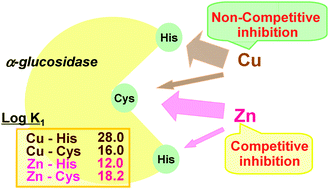Inhibitory effect of CuSO4 on α-glucosidase activity in ddY mice
Abstract
We investigated the effects of divalent alkaline earth and first-row

Maintenance work is planned for Wednesday 1st May 2024 from 9:00am to 11:00am (BST).
During this time, the performance of our website may be affected - searches may run slowly and some pages may be temporarily unavailable. If this happens, please try refreshing your web browser or try waiting two to three minutes before trying again.
We apologise for any inconvenience this might cause and thank you for your patience.
* Corresponding authors
a
Department of Analytical and Bioinorganic Chemistry, Kyoto Pharmaceutical University, 5 Nakauchi-cho, Misasagi, Yamashina-ku, Kyoto 607-8414, Japan
E-mail:
yutaka@mb.kyoto-phu.ac.jp
b Division of Diabetes, Clinical Research Institute for Endocrine and Metabolic Diseases National Hospital Organization, Kyoto Medical Center, 1-1 Mukaihata-cho, Fushimi-ku, Kyoto, Japan
c Faculty of Pharmaceutical Sciences, Suzuka University of Medical Science, 3500-3 Minami-Tamagaki-cho, Suzuka, Mie 513-8670, Japan
We investigated the effects of divalent alkaline earth and first-row

 Please wait while we load your content...
Something went wrong. Try again?
Please wait while we load your content...
Something went wrong. Try again?
 Fetching data from CrossRef.
Fetching data from CrossRef.
This may take some time to load.
Loading related content
